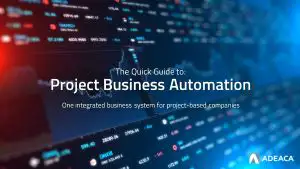In a previous blog, I discussed the top project management KPIs you should know in real time. These metrics are critical to managing any Project Business successfully. However, most companies have a difficult time generating these project management metrics at all, let alone in real time. Today I want to look at what is required to produce these types of KPIs in real time.
Everyone knows it is necessary to track these metrics in Project Business. However, if you are not actively tracking these KPIs in real time, you are simply reporting on the project instead of using them to manage the project itself.
To be able to see these project KPIs in real time requires instant dataflow between various Project Business areas, departments or even entities. Let us look at some of these metrics and what connections need to be made to generate project analytics in real time.
Project Management Metrics
Scheduled Delay – Scheduled delay is the delays in the project plan caused by insufficient capacity. It requires that the schedule be directly connected to resource management (labor and equipment). As you assign resources to the schedule through an integrated resource management module, you will easily see the Scheduled Delay instantly and can then adjust accordingly.
Slack and Backlog Tasks – Knowing your slack erosion and backlog tasks in real time means that the schedule must be a living entity that every task owner reports against ever day. It cannot simply be a Gantt chart that you print out every month and post on the wall. All team members’ time and completion reporting must be directly integrated with the schedule so as work progresses all stakeholders can see that progress against the plan.
Material Constraints – Every time a project manager looks at a project, constraints should be clearly visible. For example, it is important that as soon as a delay in arrival of material is noted in the system it produces an indicator or warning flag on the project schedule automatically. This requires that procurement and/or inventory be directly integrated with the project schedule as well. Rather than waiting for someone in procurement to call the project manager to inform him or her about a delay, the lack of material can automatically inform the manager so he or she can make adjustments immediately.
Resource Conflicts – A resource conflict occurs when a worker or piece of equipment is double booked. To see these conflicts in real time the schedule must connect directly to the resource management tool, with real-time updates of capacity, completion rates, etc. With this ability, the project manager can proactively assign resources with capacity to complete the task.
Variance – Normally calculated as part of earned value analysis, budget and cost variance should be KPIs that are automatically generated as the project progresses. Task completions and costs are incurred as soon as the project starts. Knowing how the project is doing from a budget and timeline perspective simultaneously and in real time requires that project financials and operations are completely integrated. Therefore, any changes to the project schedule that affect the budget are seen by the controller instantly. Likewise, any costs incurred that deviate from the planned budget are also known immediately.
As a Project Business we want to understand the forecasted project profitability in real time.
We want to know how a project is doing and how we think it will end up at every step of the way. This kind of project insight necessitates that the project financials and accounting be directly impacted by an always updated project schedule. This type of reporting typically occurs infrequently in most Project Businesses, and the information is usually outdated if it does.
This type of instant integration that enables these real-time insights is exactly what Project Business Automation (PBA) is all about. PBA integrates all the core project business functions in one, end-to-end system for project-based companies. Only with this type of completely integrated solution can you get to these real-time project management KPIs.
PBA is about recognizing the fact that Project Businesses are unique and require their own type of business system. Other industries, such as retail, manufacturing, and distribution, have had these types of real-time KPIs for years. Using the same exact systems that these other industries use for Project Business will not yield the same insight. You need look at things differently if you want to achieve greater insight in Project Business.
PBA provides an integrated platform for Project Businesses in a fashion similar to what these other industries have used for decades. Get to real time insight with Project Business Automation.
Learn more about how PBA from Adeaca can automate your Project Management Metrics.











